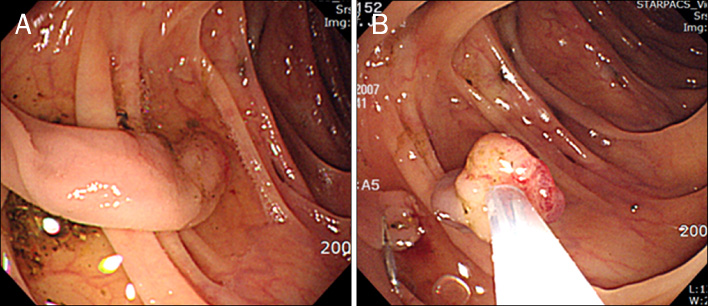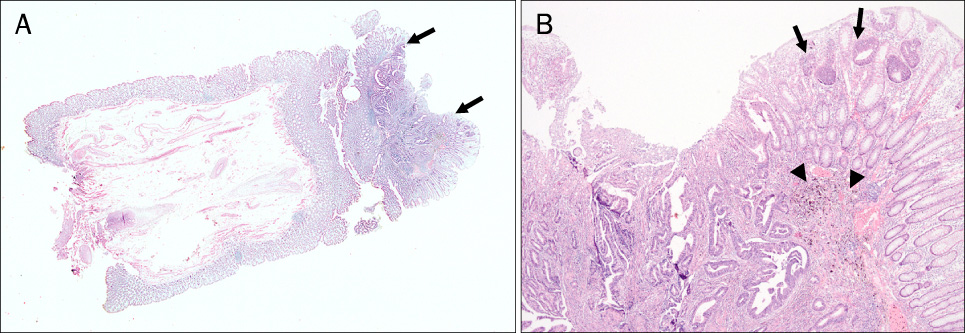Korean J Gastroenterol.
2012 Mar;59(3):257-259. 10.4166/kjg.2012.59.3.257.
A Case of Nonpolypoid Cancer Arising from Colonic Muco-submucosal Elongated Polyp
- Affiliations
-
- 1Department of Internal Medicine, Hallym University College of Medicine, Kangnam Sacred Heart Hospital, Seoul, Korea. jbkim87@hallym.or.kr
- 2Department of Pathology, Hallym University College of Medicine, Kangnam Sacred Heart Hospital, Seoul, Korea.
- KMID: 1245212
- DOI: http://doi.org/10.4166/kjg.2012.59.3.257
Abstract
- A colonic muco-submucosal elongated polyp (CMSEP) was identified at colonoscopy in a 53-year-old male patient with lower gastrointestinal bleeding. Non-polypoid depressed type of early cancer was noted at the tip of the colonic polyp. The CMSEP is very rare and incidentally found in most cases. Moreover, its association with colonic neoplasia is extremely rare. To our knowledge, this is the second case report of CMSEP associated with a cancerous transformation.
MeSH Terms
Figure
Cited by 1 articles
-
A Case of Giant Colonic Muco-submucosal Elongated Polyps Associated with Intussusception
Joo Heon Kim, Seung Yun Lee, Je Ho Jang, Hyun Young Han, Dong Wook Kang
J Pathol Transl Med. 2016;50(6):474-478. doi: 10.4132/jptm.2016.04.27.
Reference
-
1. Matake H, Matsui T, Yao T, et al. Long pedunculated colonic polyp composed of mucosa and submucosa: proposal of a new entity, colonic muco-submucosal elongated polyp. Dis Colon Rectum. 1998. 41:1557–1561.2. Akahoshi K, Matsumoto M, Kimura M, et al. Colonic muco-submucosal elongated polyp: diagnosis with endoscopic ultrasound. Br J Radiol. 2005. 78:419–421.3. Japanese Society for Cancer of the Colon and Rectum. Japanese classification of colorectal carcinoma. 1998. 6th ed. Tokyo: Kanehara Co..4. Tozawa K, Ohda Y, Matsumoto T, Hori K, Nishigami T. Clinical challenges and images in GI. Colonic mucosubmucosal elongated polyp. Gastroenterology. 2009. 136:49. 366.5. Kanazawa N, Kawahara Y, Kasahara I, Higuchi Y, Arai T, Kuroiwa K. Polypoid prolapsing mucosal folds with diverticulosis and colonic muco-submucosal elongated polyps. Geriatr Gerontol Int. 2006. 6:65–68.6. Hizawa K, Nakahara T, Inuzuka S, et al. Two cases of small non-polypoid neoplasia in an elongated colonic polyp. Endoscopy. 2001. 33:1086.7. Kurahashi T, Kaneko K, Makino R, Mitamura K. Colorectal carcinoma with special reference to growth pattern classifications: clinicopathologic characteristics and genetic changes. J Gastroenterol. 2002. 37:354–362.
- Full Text Links
- Actions
-
Cited
- CITED
-
- Close
- Share
- Similar articles
-
- A Case of Giant Colonic Muco-submucosal Elongated Polyps Associated with Intussusception
- A Case of Colonic Muco-Submucosal Elongated Polyp
- A Case of Antral and Duodenal Nonpolypoid Adenomas in a Patient with Familial Adenomatous Polyposis
- Prevalence of Upper Gastrointestinal Lesions in Patients with or without Colon Polyp and Cancer
- Colorectal Polyps : Endoscopic Diagnosis and Polypectomy



